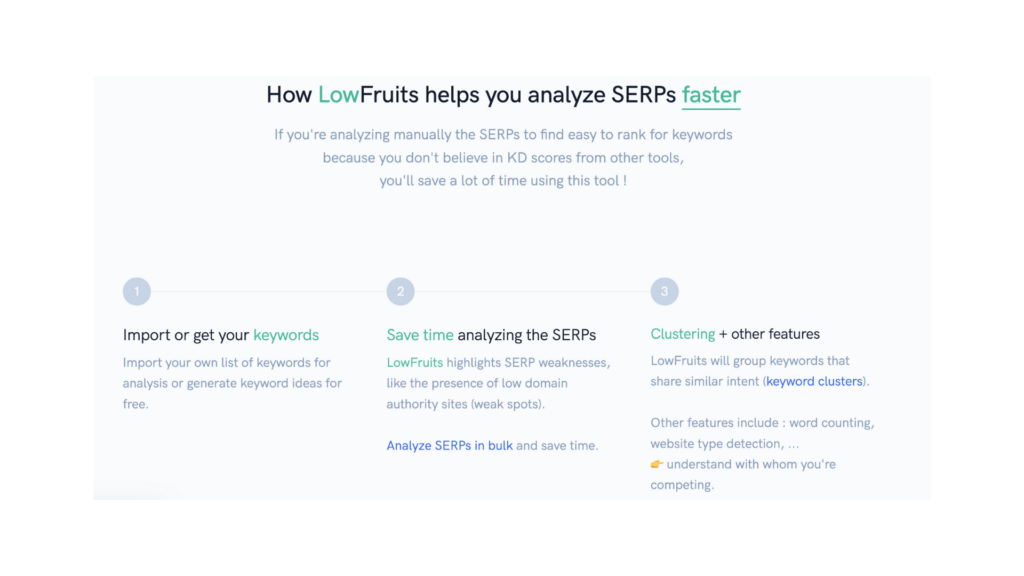This article contains affiliate links – but that doesn’t mean this piece is an ad.
All content is our honest take on the service/product and incorporates our
real thoughts and experience using it.
A great digital marketing strategy can make or break your SaaS business. Your product is online. Your customers are online. You need to find where they are and explain quickly and simply why you’re the best choice.
To get there, you need to explore every option and do a ton of testing. You also want to hone in on organic search and technical SEO for SaaS startups. There’s a reason that 50% of marketers say that organic search has the best ROI – it’s free traffic!
A comprehensive SaaS marketing audit can illuminate growth opportunities and expose potential pitfalls. It can enable entrepreneurs to make informed, data-driven decisions.
The right marketing audit tools scrutinize every aspect of your marketing operation. It’ll cover everything from lead generation to customer retention. Refining marketing efforts leads to increased engagement, improved conversions, and enhanced brand authority.
Here are 11 steps to walk you through how to conduct a thorough audit. We’ll discuss various tools and techniques to make this task more manageable and productive.
Table of Contents
Your SaaS Marketing Audit – What’s the Point?
A SaaS marketing audit might not sound like the most exciting thing in the world.
But it’s necessary.
Think of it like a dentist appointment or annual checkup at your PCP. It’s not exciting. You may even dread it. Yet, you need to do it for the good of your health.
But it’s not what keeps you healthy, right? Brushing twice a day keeps your mouth in good shape. The hour a day in the gym keeps you from getting overweight. It’s eating the right foods that keep your annual bloodwork looking good.
Implementing the right B2B SaaS digital marketing strategies keeps your business healthy. A marketing audit is a checkup to see how those efforts are progressing.
The purpose is to take a good, hard look at your current marketing efforts. You want to figure out what’s working, what isn’t, and where you can improve.
By conducting an audit, you can identify any areas of weakness in your marketing strategy and develop better ways to reach your target audience.
When Should You Perform a SaaS Marketing Audit?
Ideally, you should conduct a marketing audit at least once a year. It will give you a comprehensive overview of your current status. It also constructs a foundation to track changes and progress over time.
However, depending on your company’s size and growth rate, you may choose to do an audit more frequently. Some companies may run an audit every six months or quarterly.
Step 1: Redefine Your Goals
Now, let’s get into the meat and potatoes.
Before you start assessing your marketing efforts, establish clear audit goals. Something may have changed. It could be the market, your product, or something else going on in the world.
These objectives will help guide your evaluation and ensure that you focus on the most critical areas for improvement. Some common goals for an audit may include:
- Identifying inefficiencies in lead generation and conversion strategies
- Evaluating the effectiveness of current customer retention tactics
- Analyzing the performance of different marketing channels and campaigns
- Assessing the overall brand messaging and positioning
Every company is going to have a different set of goals. What a startup performing its first audit is looking for will be completely different from an established business with a decade of growth and audits under its belt.
Feel free to ask around. What are other people doing?
Read some content from experts. What do they think?
There are lots of SaaS gurus around. Some stick to the status quo, and others go a little more outside of the box.
But at the end of the day, it’s your business. What’s right for this audit is going to be up to you.
It shouldn’t be the last. And you can change goals every audit. You want to be as fluid as possible here.
Step 2: Gather Data and Metrics

Once you have goals, decide what metrics and data you’ll need. Gather that information to assess your current status.
It will provide a baseline for comparison as you identify areas for improvement. Some useful tools for collecting this data include:
- Google Analytics – Tracks website traffic, user behavior, and conversions
- Social media analytics – Measures engagement, reach, and demographics of your social media audience
- Email marketing platforms – Tracks open rates, click-through rates, and conversions from email campaigns
- Customer relationship management (CRM) software – Stores customer data and tracks interactions with leads and customers
The data should tell a story. If you don’t see any narrative developing, it may be a good idea to backtrack and focus on one element at a time. But if your company is really new and only recently launched, there may not be much story to tell. Yet!
Step 3: Evaluate Website Performance With a SaaS Website Audit

Your website is your digital storefront and the primary touchpoint for potential customers. One of the best practices for SaaS websites is evaluating website performance with a website audit.
Some key areas to assess include:
- User experience (UX) – How easy can visitors navigate and find information on your site?
- Search engine optimization (SEO) – How well is your website optimized for search engines?
- Lead generation – Are there clear calls-to-action and lead capture forms on your site?
- Landing pages – Do they effectively convert visitors into leads or customers?
Step 4: Analyze Your Marketing Channels
Next, take a deep dive into your SaaS digital marketing plan and budget. What channels are you actually using? They determine your effectiveness in reaching the target audience. Some essential areas to assess include:
- Paid advertising – Measure the ROI of your ad campaigns. Identify which platforms are most profitable and effective.
- Content marketing – Evaluate the performance of your content in terms of engagement, conversions, and lead generation. We’ll go more into this in a bit.
- Social media – Analyze the effectiveness of different social media platforms. How well are they reaching your target audience? More on this further down the post.
You’re probably starting to see some patterns at this point. Everything, from basic website design to marketing, are all interconnected. There is no one thing you can do that guarantees success.
It’s all a puzzle. All the pieces need to fit together. They all have to be of excellent quality or the picture presented won’t be attractive to customers.
Step 5: Technical SEO for SaaS Businesses – Scrutinize Your Strategy… Hard

Search engine optimization is the backbone of any online marketing strategy. Technical SEO for SaaS companies is one of the few areas where you have total control.
As part of your audit, review your SEO tactics. Are they driving relevant traffic to your website? Some important areas to consider include:
- Keyword research and usage – Are you targeting the right keywords? How effectively are you using them?
- On-page optimization – Do your website’s pages have proper titles, headings, and meta descriptions? Are you providing internal links?
- Backlink profile – Evaluate the quality and quantity of links directing to your website. Use tools like LowFruits and Moz to keep an eye on your links. Competitors will pay for scam links to the opposition’s websites to hurt their rankings.
Step 6: SaaS Content Audit and Optimization
Performing regular content audits will be one of your most powerful protocols for optimization. Companies use it to educate, engage, and convert potential customers.
Perform a thorough SaaS content audit, review your strategies, and determine how it can achieve better results. Place a focus on these areas for your first audit:
- Content quality – Are you producing high-quality, relevant content that resonates with your target audience?
- Content distribution – Are you effectively promoting your content through the right channels?
- Content conversion – Do you have clear calls to action in your content to convert readers into leads or customers?
Step 7: Assess Social Media Presence and Engagement
Social media is the best way for SaaS businesses to connect with their audience. You’ll also build brand awareness and drive engagement.
This is why it’s so important to evaluate your social media presence. You want to determine the effectiveness of your efforts in meeting your marketing goals.
Some key areas to assess include:
- Audience engagement – Are you effectively engaging with your followers through comments, likes, and shares?
- Follower growth – Are you steadily growing your social media audience, and is it relevant to your target market?
- Platform effectiveness – Evaluate which social media platforms are most effective for your goals.
Step 8: Email Marketing Strategies
Email marketing has the best ROI of any marketing tactic. It’s kind of a combination of content and social media and deserves its own section. It also has tactics that only work with email.
If you’re not doing well in this category, you need to fix it immediately. Go through your strategies to ensure they drive engagement and conversions.
Keep the following considerations in mind:
- Email list quality – Is your email list composed of engaged and relevant subscribers? If not, maybe you’re sending too many emails. Maybe they’re low quality. Or maybe you’re focusing on the wrong places within the sales funnel.
- Campaign performance – Measure the success of different email campaigns regarding open rates, click-through rates, and conversions.
- Automation – Evaluate the effectiveness of automation to nurture leads and engage with customers. Just because AI is what’s hot in the streets doesn’t mean your customer base will respond well to it.
Step 9: Analyze Customer Retention Tactics
Acquiring new customers is fantastic. But with the SaaS model, retaining existing ones is the holy grail to long-term success.
As part of your audit, review your customer retention strategies to identify areas for improvement. Some critical areas to consider include:
- Onboarding process – Evaluate your onboarding process. Is it getting in new customers? How easy is the process to get them started with your product?
- Customer communication – Engage with customers regularly and provide valuable information and support.
- Customer feedback – Gather customer feedback to identify pain points and areas for improvement.
Step 10: Use SaaS Marketing Audit Tools
Use various tools and techniques to collect data. They help analyze your SaaS marketing audit efforts effectively.
Here are some of the best marketing audit tools in the business:
- LowFruits – Analyze SERPs, find longtail keyword ideas, and create keyword clusters easily.

- Hootsuite – Manage and track social media activity across different platforms.

- ActiveCampaign – Create and track email campaigns.

- Google Analytics – Gather data on website traffic, user behavior, and conversions from the search engine that’s responsible for ranking your website.

Always use the right tools for the job. You wouldn’t use a hammer to unscrew a light bulb.
They’ll improve your marketing performance and help you make data-driven decisions.
The best tools will also offer valuable insights into your competitors’ strategies. This will help identify gaps and opportunities in the market.
Step 11: Identify Growth Opportunities and Implement Changes
You should have a clear idea of your company’s progress after completing a marketing audit.
Use this knowledge to identify potential growth opportunities and areas needing improvement.
With this information, you can decide where to allocate resources. You can hone your tactics to increase engagement, conversions, and brand authority.
The final step in a marketing audit is to implement changes and track progress.
Set specific goals and timelines, regularly review data, and adjust your strategies accordingly.
Don’t Get Hit By Bad News From Your Check-Up – Perform a SaaS Marketing Audit Today
A SaaS marketing audit comprehensively and systematically examines a company’s digital marketing landscape.
It’s a necessity for SaaS entrepreneurs who aim to make data-driven decisions that will drive growth.
Meticulously review and analyze each aspect of the marketing mix:
- Technical SEO for SaaS companies
- Social media presence
- Email marketing strategies
- Customer retention tactics
- SaaS content audit
Use the right marketing audit tools for insights into performance.
This ultimately aids in identifying growth opportunities. Post-audit, the successful implementation of changes and consistent monitoring of progress are equally crucial to ensure long-term success.
Keeping up with the best practices for SaaS websites regularly will keep your business agile. This will trigger a natural form of evolution.
You’ll stay ahead simply by “going to the gym” and “getting a regular checkup”. Your business will stay vibrant and full of life for years to come.





Your point of view caught my eye and was very interesting. Thanks. I have a question for you.
Glad to hear you enjoyed reading this piece. Sure, you can email maddy@techtonic-marketing.com for any questions you may have.
Thanks for sharing. I read many of your blog posts, cool, your blog is very good.
It’s our pleasure, glad you are enjoying our posts!